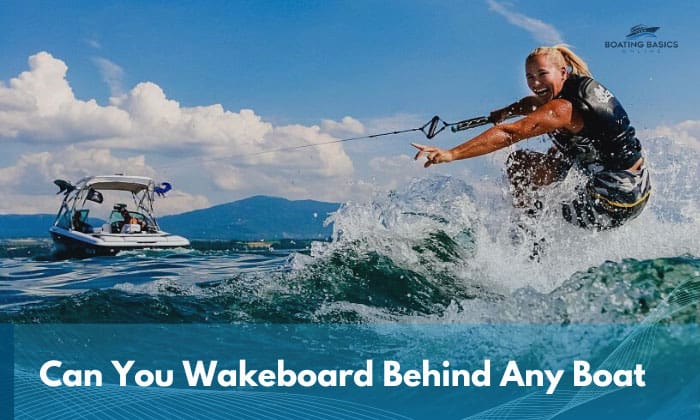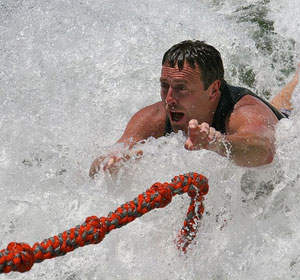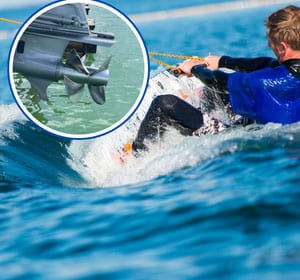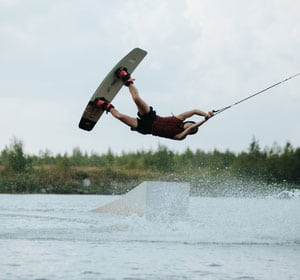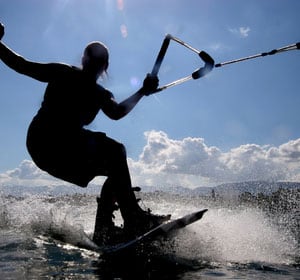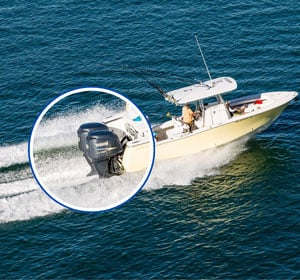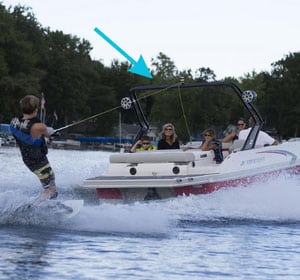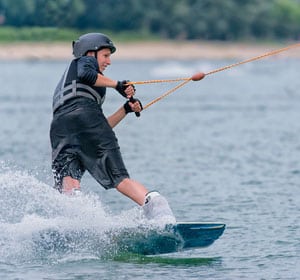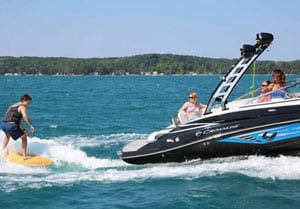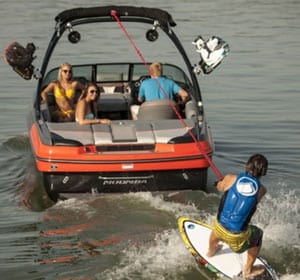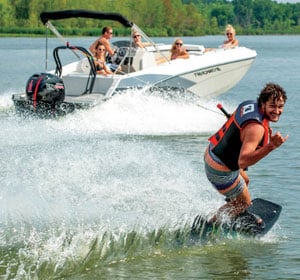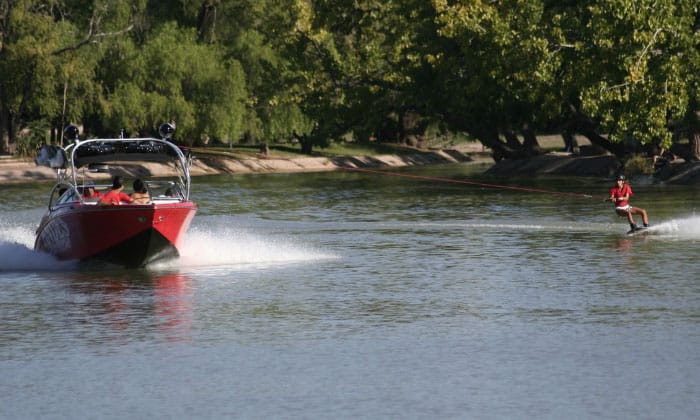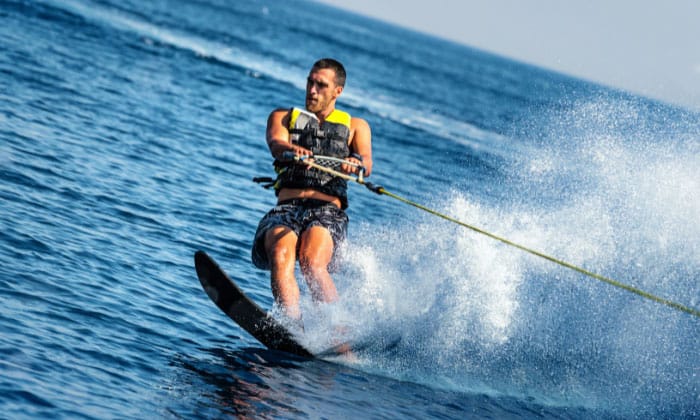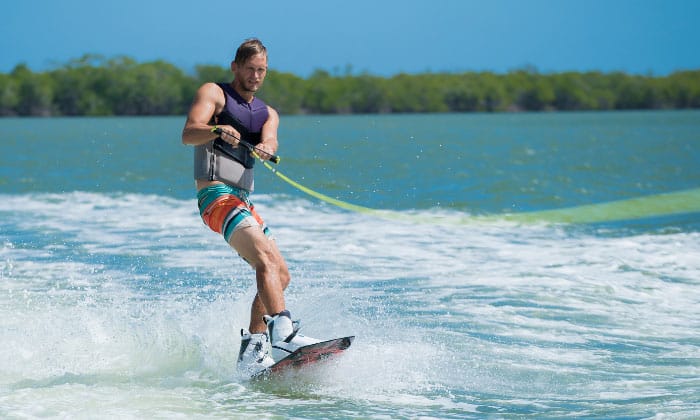With watersports boat prices on the steep side, we can’t blame wakeboarders who ask, “Can you wakeboard behind any boat?”
There may be videos online or first-hand accounts telling you it’s possible. But the safest recommendation is that you shouldn’t wakeboard behind any boat.
You likely won’t enjoy it because of the subpar wakes the boat will make. More importantly, you’ll put yourself at needless risk of serious injury.
Table of Contents
- Reasons Why You Shouldn’t Wakeboard Behind Any Boat
- What Boat Types Suit Wakeboarding
- How Boat Design Affects Wakeboarding Performance
- Pros (and Cons) for Each Boat Type
- Factors Affecting Wakeboarding Suitability
- Surfing Behind a Boat Safety Guide
- Safety Considerations for Wakeboarding
- Frequently Asked Questions
- Conclusion
Reasons Why You Shouldn’t Wakeboard Behind Any Boat
The general consensus among experienced wakeboarders is that it’s not worth wakeboarding behind a ski boat because it’s simply no fun. What more for “regular” boats like center consoles, jon boats, fishing boats, or even kayaks with insufficient engine power, top speed, and woefully poor wakes?
And, really, the lack of enjoyment shouldn’t be your main turn-off. Rather, you should be looking more at the danger you’ll be putting yourself and other riders and wakeboarders in.
Risks, potential damages
1. Innate danger of wakeboarding and wake surfing
Understand that wakeboarding itself is a relatively risky activity, especially for beginners. Surfing behind a boat with a rope has led to people suffering concussions, cracked ribs, abrasions, fractures, traumatic brain damage, and other serious wake surfing injuries.
And, that’s the case even if people are already wearing the right equipment and using the correct vessel.
2. Possibility of hitting the prop
Most vessels that aren’t wake boats or ski boats use either an outboard motor or an I/O (inboard/outboard) one. These often have exposed propellers that people may hit, leading to nasty, life-threatening accidents.
Whenever you surf behind a boat, you often come close to the watercraft, so the risk is undoubtedly high. I don’t know about you, but I’d be a bundle of nerves if I ever had to wakeboard behind an outboard or behind a sterndrive because of that possibility alone.
3. Fluctuating speed
Wakesurfers’ speed rarely stays static as well, especially if they’re already without rope. There will inevitably be instances when they accelerate enough to catch the boat and hit it. Also, what if the boat operator suddenly decided to slow down? You never know.
Boats that can’t hold their speed due to a weaker motor or wrong hull design obviously impart the most risk in this regard. Usually, you’ll have to wait for the optimal water conditions just to make sure that the boat will not fail you – and even then, the wakes will almost always stay unsatisfactory.
4. Use of improper equipment
If you aren’t using the correct boat, chances are, you’re also less likely to use the right equipment. Did you know that it’s not safe to use any kind of tow rope for wakeboarding other than what’s specifically designed for it? Ropes are meant to keep you safe and accommodate your gradual improvement.
They need to have the proper length (usually between 55 to 75 feet) and thickness. The size and weight of the handles must also suit the rider.
What Boat Types Suit Wakeboarding
To know the correct boats you can surf behind, you need to look at how wake boats are designed, particularly the ones that have been well-received by experienced wakeboarders and surfers.
How Boat Design Affects Wakeboarding Performance
Here’s the bare minimum required for a wakeboarding boat:
1. Powerful engine
The boat has to be powered by a motor that will pull the rider comfortably out of and on top of the water. All the while, it should be able to maintain a consistent speed, since we’re talking about staying connected to the boat for the entire ride and not wake surfing, where no rope will be involved once you get the hang of the wave.
2. Ballast system
The internal ballast is responsible for creating the big wakes necessary for an authentic wakeboarding experience. Ballasts have to be optimally placed throughout the boat to keep bow height optimal. They should also fill up and drain quickly to ensure a smooth, responsive wakeboarding experience all throughout.
3. Tower
This serves the purpose of an attachment point for the tow rope. It’s designed to elevate the rider to impart the optimal angle and keep them in the air for longer.
This is another specialized component only found in wake boats.
4. Hull design
Most wake surf boats incorporate a deep-V hull that can handle all the chop, (especially if you’re surfing in the ocean), heighten fuel efficiency, and help in providing a surfable wave.
Now, imagine using a boat with a planing or displacement hull that barely makes wakes. You’ll be left with nothing to ride!
5. Wake size control
Most wake boats have a specialized system that lets you switch the wave from side to side to readily adjust the wave steepness. Again, this only contributes to the enjoyment and safety of the surfers.
You can add all the weight and try to surf behind a pontoon, but can it do this?
Pros (and Cons) for Each Boat Type
As long as your boat meets the design and componentry mentioned above, it should get a green checkmark for wakeboarding or wake surfing. Otherwise, you have to cross it out.
To further prove this point, I’ve outlined the pros and cons for each boat type based on their drive systems:
1. V-Drive
Pros
- Inboard engines with V-drives are the gold standard for most wake boats.
- The prop is safely out of the way.
- Aids in creating great wakes
Cons
- May be difficult to put the boat on plane if it’s too large
2. Direct Drive
Pros
- Another safe option as the prop is not exposed
- Fuel-efficient
- Turns on a dime
Cons
- May be more suitable for water skiing due to engine placement in the middle
3. Outboard and I/O
Pros
- In the context of wakeboarding safety, there are none
Cons
- Inherently dangerous due to prop exposure
- Absence of high-quality wakes
Factors Affecting Wakeboarding Suitability
So, before you decide to wakeboard behind different boats, remember that it should:
- Have a hull that can help generate large, well-shaped wakes.
- Integrate a ballast system for creating the wake and modifying its size and shape.
- Have a tower that can easily adjust the angle of the tow rope for optimal lift.
- Offer power and speed control.
- Have a wake-shaping system to make the riding experience more dynamic.
- Be able to maneuver well and have great overall handling.
- Keep the ride stable.
And that’s just the minimum, really. We haven’t even touched upon seating, passenger capacity, customization, and storage space, which are factors that a lot of wake boat manufacturers don’t exactly sneeze at.
Surfing Behind a Boat Safety Guide
As long as you adopt a safety-first mindset when wakeboarding, you’ll only spare yourself from unnecessary headaches (both literal and figurative) down the road.
Safety Considerations for Wakeboarding
Remember these wakeboarding boat requirements to lower your risk:
- Keep a life jacket on every time you’re on or in the water.
- Only wakeboard in an area you know that is safe for this kind of activity and if the weather conditions are right.
- Learn basic safety guidelines like proper rope handling, balancing, distancing, etc.
- Take the time to practice and hone your swimming skills.
- Don’t forget to communicate with your driver. All the better if you can assign a spotter to help avoid obstacles and to alert each other if something goes awry.
- Wash, maintain, and repair both your boat and wakeboard after you’re done.
Important features:
- Safety lanyard or engine cut-off switch
- Personal flotation devices
- GPS
Speed and weight requirements considerations
Here are the boat considerations for wakeboarding related to speed and weight for additional safety:
- Don’t overload your boat.
- Don’t go over the speed limit.
- The boat should be able to smoothly adjust its speed based on the rider’s experience level.
- Boats have to be weighted down evenly from port to starboard. If you have a ballast system, this shouldn’t be a problem.
Frequently Asked Questions
Why should you never wakesurf with a standard wakeboarding tow rope?
For one, a wakeboarding rope is longer than a rope designed for wakesurfing. Manufacturers also make wakesurfing ropes thicker and sturdier, with knots for freedom in adjusting the length they need.
All of these are done to ensure riders will be comfortable and smoothly ride the wake until they’re confident enough to do it without the rope.
Can I wakeboard without a boat?
No, wakeboarding involves holding onto a tow rope as you ride and jump over wakes and waves. It’s impossible to do this without a vessel. Even surfing behind a boat requires you to hold onto a rope tied to the watercraft for a time.
Tips for selecting the right boat for wakeboarding
Just remember the factors I’ve shared here, like using either only a V-drive or direct drive, ensuring it has a deep-V hull, a working ballast system and tower, the right safety gear, and wake size and shape customization, to cite a few of the essentials.
Conclusion
I hope this has convinced you once and for all that the answer to “Can you wakeboard behind any boat?” is a resounding no. You basically double the risk that you already have every time you go out there and get your needed dose of thrilling rides and adrenaline-pumping jumps.
There’s always the option to rent a wakeboard boat if budget’s an issue. The point is to do it properly every time.

“My intention from the first day establishing Boating Basics Online is to provide as much help as possible for boaters who want to experience a first safe and convenient trip. So feel free to join us and share your beautiful journeys to the sea!”

